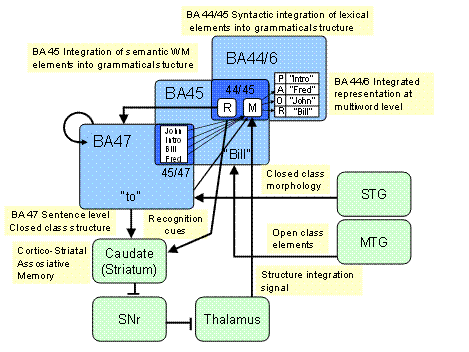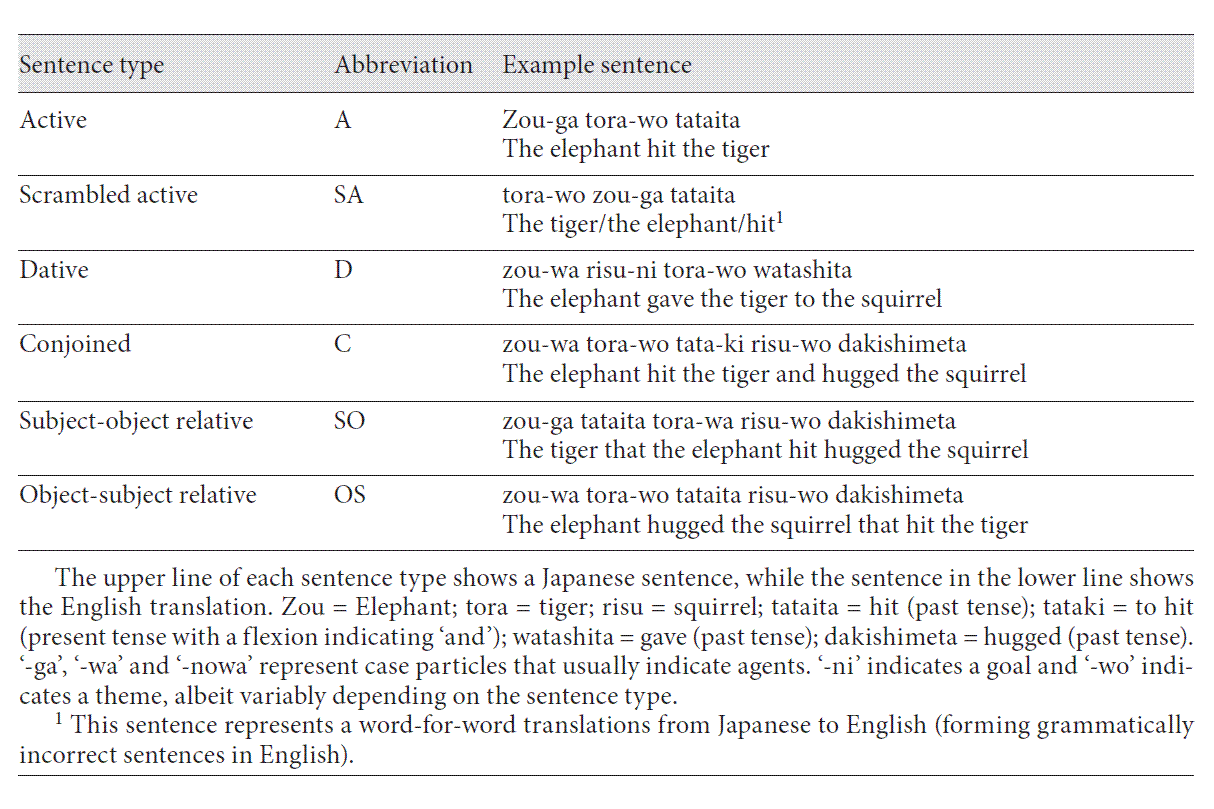Imitation and Language
The fronto-parietal mirror neuron system is important for both the recognition and execution of sequential actions. This system, which is included in the traditional language areas, is a core circuit for imitation. Autism, a type of communication disorders, involves a dysfunction of the mirror neuron system, and we assume that echolalia and visually-matched imitation (not body-centered imitation: for example, autistic children waving “bye-bye” by presenting their palms to the imitator, but not to the model) are reciprocally correlated. Based on this idea, we investigated the relationship between object manipulation and syntactic processing, and constructed a brain model of language acquisition and comprehension, which includes basal ganglia.
Object manipulation and syntactic comprehension
One of the major goals for development in young children is to establish various reference frames. This establishment is based on understanding the triadic relations (self-other-object) that are acquired through a joint attention mechanism. On the basis of this relational understanding, children could acquire various verbal functions, such as understanding and producing syntactic complex sentences. As for syntactic structure, children must learn juxtaposition and hierarchical relations among multiple arguments, such as agent, theme, goal, etc. Although the link between the frontal lobe (Broca’s area and the adjacent area) and the parietal lobe (especially the inferior parietal lobule) is known to be necessary for syntactic comprehension, how each of these areas acts on syntactic processing is not yet clear.
Nagai et al. [Nagai, 2006 in Japanese] [Nagai2010] investigated the syntactic comprehension ability of infarct patients with restricted lesions in the parts opercularis (Op: BA44) and parts trianglaris (Tr: BA45) of Broca’s region. Using the Object Manipulation Task (subjects were required to manipulate a toy animal after listening to a reversible sentence; e.g., “A squirrel gave an elephant to a tiger.” See Table 1), accuracy and error types were compared between patient groups. As a result, the Op group displayed difficulty with relative sentences, whereas the Tr group showed more difficulty with dative sentences than with relative sentences. The Tr group tended to posit items in canonical order, while the Op group posited items in random order. These results indicate that the parts opercularis involves dynamic syntactic processing, such as replacing thematic roles and reinterpretation, whereas the parts trianglaris involves a rather static processing of semantic relations among equivalent items with fixed thematic roles. Furthermore, we also investigated the syntactic ability of patients with lesions in the inferior parietal lobule (BA 39) using the same task [Inui2008 in Japanese]; we found that their behaviors were similar to those of the Tr group. This indicates that the fronto-parietal relation in syntactic comprehension consists of BA 45-39 and BA 44-40 lines. We consider that, while the former line is related to the semantic aspects of syntactic simulations, the latter is involved in dynamic sequential processing. In addition, another subregion of the inferior frontal gyrus, the parts orbitalis (BA47), is not within Broca’s area, but is adjacent to the parts trianglaris, and was reported to have been activated in the processing of particles in Japanese, rather than phonological processing in a fMRI study. Considering the above data, the parts trianglaris and orbitalis appear to work together to consolidate the assignment of thematic roles.
Table. 1 Sentences used in the object manipulation task [Nagai2010]
Brain mechanisms of syntactic processing and semantic interpretation
The syntactic processing of center-embedded (CE) sentences entails understanding complex hierarchical structures. Our previous study showed that the left dorsal prefrontal cortex (LDPFC) was more activated when comprehending CE than left-branching sentences (LB). However, the specific role of this region in the processing of complex sentences remains uncertain. We used an fMRI to investigate the roles of LDPFC in the syntactic processing of complex sentences, using three types of sentences with different structures (LB, CE, and active-conjoined (AC) sentences) [Ogawa2008]. Three meaningless characters—X, Y, and Z—were used as nouns, with X as the agent and Y and Z as the objects. Two Japanese verbs were randomly chosen from the following three verbs: tataita, oshita, and taoshita (“hit,” “pushed,” and “knocked down,” respectively). Two Japanese particles, ga and o, which are case markers for the agent and object respectively, were used as functional words. Examples of each sentence type are as follows: LB – Y-o tataita X-ga Z-o oshita; CE – Y-o Z-o oshita X-ga tataita; AC – X-ga Y-o tataite Z-o oshita. General syntactic complexity is increased with AC, LB, and CE sentences, in that order. Our findings revealed selectively increased activation in the LDPFC for CE, with no significant difference between LB and AC, indicating that LDPFC activity is not related to general syntactic complexity, but is specific to the processing of CE structures, which requires a greater load in the syntactic buffer or a higher integration cost.
In addition, we extended our previous brain model, and suggested a language acquisition and comprehension model [Dominey2009]. This model, which consists of Broca’s area, BA 47, and basal ganglia, can acquire syntactic operations and symbol grounding. The model’s architecture is illustrated in Figure 1. We modeled BA47 as a recurrent network that takes into account the current closed class element, as well as the previous closed class elements, with this history being encoded by information flow through the recurrent connections. BA47 projects to the head of the caudate, and via the ‘‘canonical’’ cortico-striato-nigro-thalamo-cortico circuit, projects to BA44/45. While the current open class word is represented in BA45, the sentence-level integrated meaning is represented in BA44/6. The word level meaning (BA45) must become bound with the properly assigned thematic role and integrated into the sentence-level meaning in BA44/6.

Fig. 1 Brain network model for language acquisition and comprehension. [Dominey2009]
We investigated the syntactic function of a patient who suffered lesions of the left caudate nucleus at age 6. The results suggest that this patient’s impaired grammatical function is largely confined to the components expected to be acquired after age 6, and is apparently correlated with age at onset and lesion site [Nagai2010] [Nagai2009]. This fact indicates that the left caudate nucleus is crucial for the acquisition of high-level syntactic ability.
In autism, imitation deficits may influence some functions that are acquired later, such as language. We investigated the relationship between imitation and the parietal lobe. As a result, we found that dysfunction of the left parietal lobe crucially affects the acquisition of imitation, and the right parietal lobe is involved in joint attention [Eguchi2008]. These findings are important for the study of developmental disorders in autism.
Modeling the basic communication functions
Williams syndrome (WS) patients have difficulty copying the drawings of objects. We considered that such a disability is caused by deficits of (i) visuospatial working memory during drawing behavior, (ii) feature detection of the target figure, (iii) coordinate transformation of the target figure onto the new drawing space, and (iv) inhibition function. WS children show disproportionate development of global processing, which affects not only drawing abilities, but other aspects of daily communication as well. Investigating the relationship between atypical development and hypersociability in WS children is a future work.
To investigate the relationship between shifts of visuospatial attention and the grammatical subject, we performed two fMRI experiments. In the first experiment, participants observed an event picture in which a red and a blue object moved together, immediately after their perspective was guided to a particular object by a spatial cue. Participants were then required to judge whether the presented sentence correctly described the previous event [Iwabuchi2009]. We hypothesized that when the perspective during event observation was incongruent with the subsequent grammatical subject, perspective shift should occur. An analysis of reaction times indicated that perspective shift occurred in such incongruent conditions; we showed that the right dorsolateral prefrontal cortex (DLPFC) was significantly more activated for the incongruent conditions. The procedure in the second experiment was similar to the first, but we used event pictures in which the thematic roles of the referents were more specific in order to investigate brain activities in more realistic situations [Iwabuchi2011, submitted]. In addition, participants were instructed to verbalize the event internally during event presentation, using a cued object as the sentential subject. Consequently, the right DLPFC activity was marginally significant, and the superior parietal lobule/precuneus (SPL/PCun) activity was significant for the conditions requiring perspective shift. Taken together, these findings indicate that mental imagery is activated in SPL/PCun, and that the right DLPFC subserves perspective shift by inhibiting/disengaging the visuospatial perspective in the mental imagery.
In the final year, we will investigate either the mechanism of selection or the transformation of reference frames in discourse situations. By elucidating the relationship between language comprehension and turn-taking or perspective shift during conversation, we will refine and extend our model of language acquisition and comprehension to be able to explain the mechanism of complex sentence comprehension.
It is not clear how we understand simple sentences like “she grasps a cup.” As described above, the mirror neuron system represents actions such as grasping, but it cannot assign thematic roles (e.g., agent or patient) to those actions. According to previous studies, the information about agency seems to be represented in the parietal lobe, while the information about an object is represented in the inferior temporal lobe. To understand a simple sentence (e.g., “I grasp a cup.”), such semantic information and action information in the mirror neuron system must be appropriately bound. In addition, taking into account the results of our fMRI studies about perspective shift and complex sentence comprehension, we consider that the left BA 9 is involved in the shifting of hierarchical levels (e.g., main clause or subordinate clause) in language comprehension. Supported by such functions, information binding takes place at each hierarchical level. Based on these trends and findings, we suggest the following hypothesis:
Hypothesis: The right BA 9 is involved in perspective shift; the left BA 9, on the other hand, is involved in hierarchical processing in sentence comprehension. These areas are associated with executive functions of working memory, especially set shifting regarding dimensions of information.

